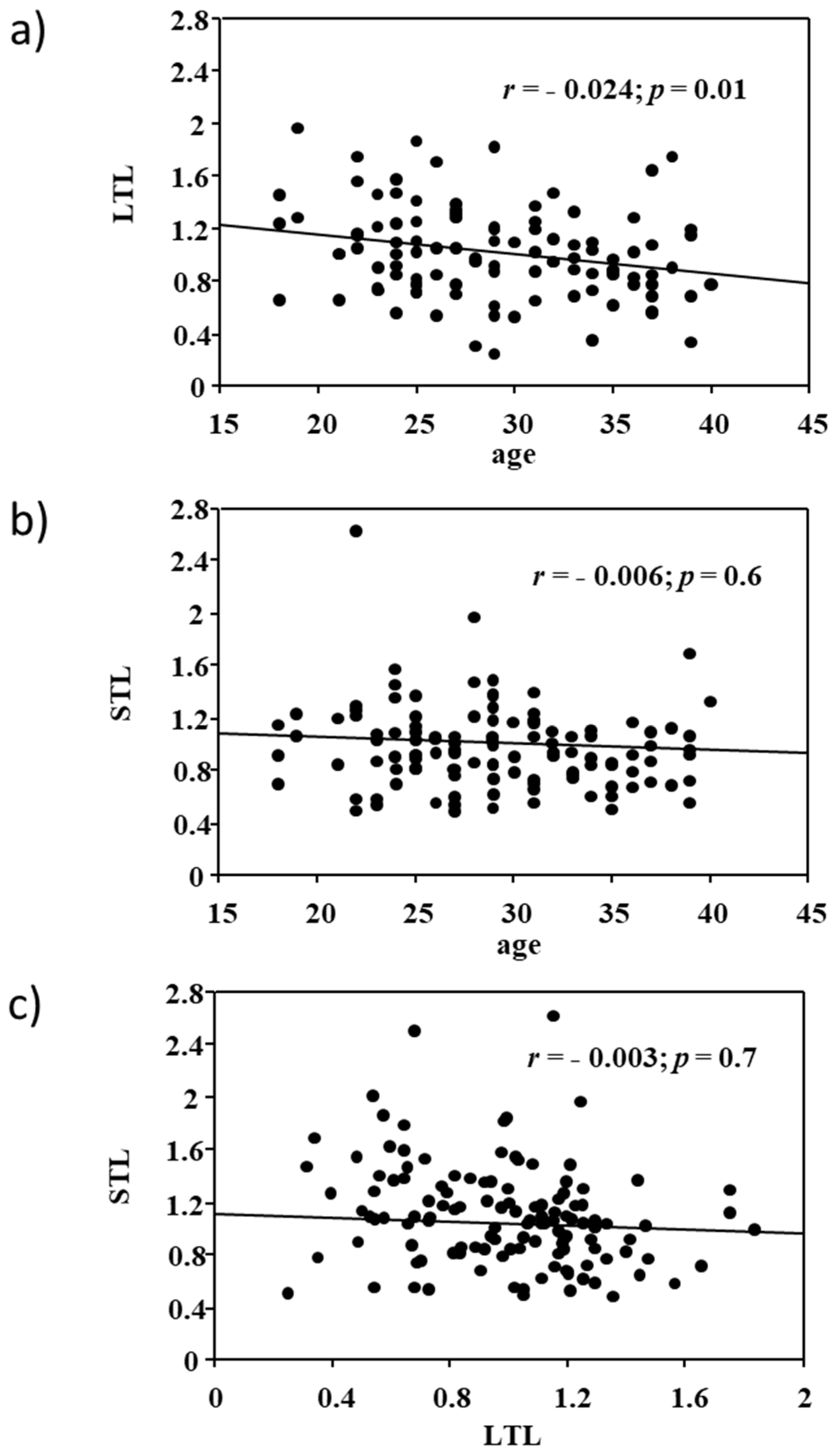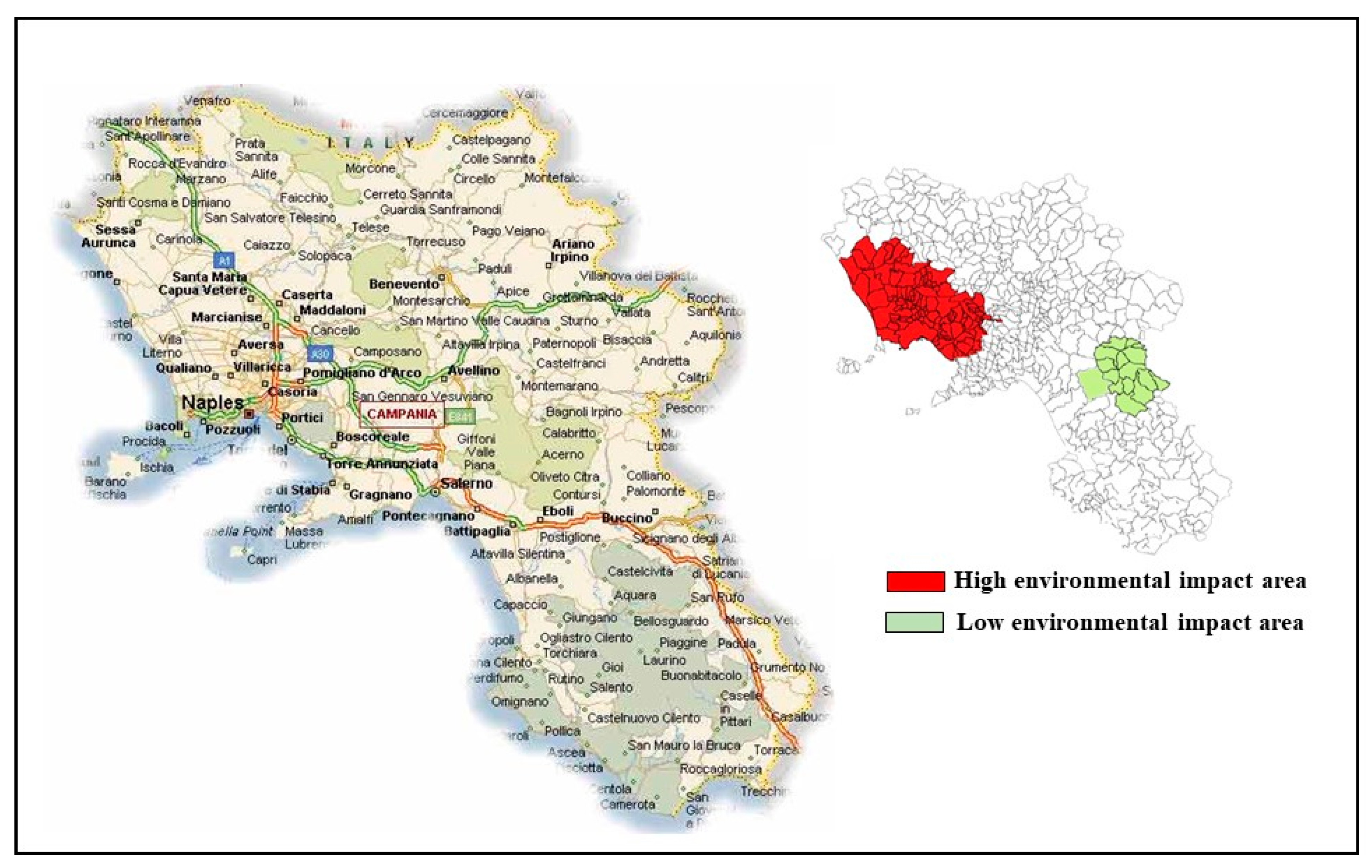Effects of Highly Polluted Environment on Sperm Telomere Length: A Pilot Study
Abstract
:1. Introduction
2. Results
3. Discussion
3.1. Comparison with Other Studies
3.2. Study Limitations
4. Materials and Methods
4.1. Study Population
4.2. Semen Quality Evaluation
4.3. Telomere Length Analysis
4.4. Statistical Analysis
5. Conclusions
Acknowledgments
Author Contributions
Conflicts of Interest
References
- Asklund, C.; Jorgensen, N.; Skakkebaek, N.E.; Jensen, T.K. Increased frequency of reproductive health problems among fathers of boys with hypospadias. Hum. Reprod. 2007, 22, 2639–2646. [Google Scholar] [CrossRef] [PubMed]
- Hanson, H.A.; Mayer, E.N.; Anderson, R.E.; Aston, K.I.; Carrell, D.T.; Berger, J.; Lowrance, W.T.; Smith, K.R.; Hotaling, J.M. Risk of childhood mortality in family members of men with poor semen quality. Hum. Reprod. 2017, 32, 239–247. [Google Scholar] [CrossRef] [PubMed]
- Deng, Z.; Chen, F.; Zhang, M.; Lan, L.; Qiao, Z.; Cui, Y.; An, J.; Wang, N.; Fan, Z.; Zhao, X.; Li, X. Association between air pollution and sperm quality: A systematic review and meta-analysis. Environ. Pollut. 2016, 208, 663–669. [Google Scholar] [CrossRef] [PubMed]
- Vecoli, C.; Montano, L.; Andreassi, M.G. Environmental pollutants: Genetic damage and epigenetic changes in male germ cells. Environ. Sci. Pollut. Res. Int. 2016, 23, 23339–23348. [Google Scholar] [CrossRef] [PubMed]
- Aitken, R.J.; de Iuliis, G.N.; Finnie, J.M.; Hedges, A.; McLachlan, R.I. Analysis of the relationships between oxidative stress, DNA damage and sperm vitality in a patient population: Development of diagnostic criteria. Hum. Reprod. 2010, 25, 2415–2426. [Google Scholar] [CrossRef] [PubMed]
- Thilagavathi, J.; Venkatesh, S.; Dada, R. Telomere length in reproduction. Andrologia 2013, 45, 289–304. [Google Scholar] [CrossRef] [PubMed]
- Rocca, M.S.; Speltra, E.; Menegazzo, M.; Garolla, A.; Foresta, C.; Ferlin, A. Sperm telomere length as a parameter of sperm quality in normozoospermic men. Hum. Reprod. 2016, 31, 1158–1163. [Google Scholar] [CrossRef] [PubMed]
- Cariati, F.; Jaroudi, S.; Alfarawati, S.; Raberi, A.; Alviggi, C.; Pivonello, R.; Wells, D. Investigation of sperm telomere length as a potential marker of paternal genome integrity and semen quality. Reprod. Biomed. Online 2016, 33, 404–411. [Google Scholar] [CrossRef] [PubMed]
- Calado, R.T.; Young, N.S. Telomere diseases. N. Engl. J. Med. 2009, 361, 2353–2365. [Google Scholar] [CrossRef] [PubMed]
- Hoxha, M.; Dioni, L.; Bonzini, M.; Pesatori, A.C.; Fustinoni, S.; Cavallo, D.; Carugno, M.; Albetti, B.; Marinelli, B.; Schwartz, J.; et al. Association between leukocyte telomere shortening and exposure to traffic pollution: A cross-sectional study on traffic officers and indoor office workers. Environ. Health 2009, 8, 41. [Google Scholar] [CrossRef] [PubMed] [Green Version]
- Shin, J.Y.; Choi, Y.Y.; Jeon, H.S.; Hwang, J.H.; Kim, S.A.; Kang, J.H.; Chang, Y.S.; Jacobs, D.R., Jr.; Park, J.Y.; Lee, D.H. Low-dose persistent organic pollutants increased telomere length in peripheral leukocytes of healthy Koreans. Mutagenesis 2010, 25, 511–516. [Google Scholar] [CrossRef] [PubMed]
- Hou, L.; Wang, S.; Dou, C.; Zhang, X.; Yu, Y.; Zheng, Y.; Avula, U.; Hoxha, M.; Díaz, A.; McCracken, J.; et al. Air pollution exposure and telomere length in highly exposed subjects in Beijing, China: A repeated-measure study. Environ. Int. 2012, 48, 71–77. [Google Scholar] [CrossRef] [PubMed]
- Dioni, L.; Hoxha, M.; Nordio, F.; Bonzini, M.; Tarantini, L.; Albetti, B.; Savarese, A.; Schwartz, J.; Bertazzi, P.A.; Apostoli, P.; et al. Effects of short-term exposure to inhalable particulate matter on telomere length, telomerase expression, and telomerase methylation in steel workers. Environ. Health Perspect. 2011, 119, 622–627. [Google Scholar] [CrossRef] [PubMed]
- Li, H.; Engström, K.; Vahter, M.; Broberg, K. Arsenic exposure through drinking water is associated with longer telomeres in peripheral blood. Chem. Res. Toxicol. 2012, 25, 2333–2339. [Google Scholar] [CrossRef] [PubMed]
- Gao, J.; Roy, S.; Tong, L.; Argos, M.; Jasmine, F.; Rahaman, R.; Rakibuz-Zaman, M.; Parvez, F.; Ahmed, A.; Hore, S.K.; et al. Arsenic exposure, telomere length, and expression of telomere-related genes among Bangladeshi individuals. Environ. Res. 2015, 136, 462–469. [Google Scholar] [CrossRef] [PubMed]
- Ling, X.; Zhang, G.; Chen, Q.; Yang, H.; Sun, L.; Zhou, N.; Wang, Z.; Zou, P.; Wang, X.; Cui, Z.; et al. Shorter sperm telomere length in association with exposure to polycyclic aromatic hydrocarbons: Results from the MARHCS cohort study in Chongqing, China and in vivo animal experiments. Environ. Int. 2016, 95, 79–85. [Google Scholar] [CrossRef] [PubMed]
- Bergamo, P.; Volpe, M.G.; Lorenzetti, S.; Mantovani, A.; Notari, T.; Cocca, E.; Cerullo, S.; di Stasio, M.; Cerino, P.; Montano, L. Human semen as an early sensitive biomarker of highly polluted living environment in healthy men: A pilot biomonitoring study on trace elements in blood and semen and their relationship with sperm quality and RedOx status. Reprod. Toxicol. 2016, 66, 1–9. [Google Scholar] [CrossRef] [PubMed]
- Zalenskaya, I.A.; Bradbury, E.M.; Zalensky, A.O. Chromatin structure of telomere domain in human sperm. Biochem. Biophys. Res. Commun. 2000, 279, 213–218. [Google Scholar] [CrossRef] [PubMed]
- Yang, Q.; Zhao, F.; Dai, S.; Zhang, N.; Zhao, W.; Bai, R.; Sun, Y. Sperm telomere length is positively associated with the quality of early embryonic development. Hum. Reprod. 2015, 30, 1876–1881. [Google Scholar] [CrossRef] [PubMed]
- Aston, K.I.; Hunt, S.C.; Susser, E.; Kimura, M.; Factor-Litvak, P.; Carrell, D.; Aviv, A. Divergence of sperm and leukocyte age-dependent telomere dynamics: Implications for male-driven evolution of telomere length in humans. Mol. Hum. Reprod. 2012, 18, 517–522. [Google Scholar] [CrossRef] [PubMed]
- Hou, L.; Zhang, X.; Gawron, A.J.; Liu, J. Surrogate tissue telomere length and cancer risk: Shorter or longer? Cancer Lett. 2012, 319, 130–135. [Google Scholar] [CrossRef] [PubMed]
- Rode, L.; Nordestgaard, B.G.; Bojesen, S.E. Long telomeres and cancer risk among 95,568 individuals from the general population. Int. J. Epidemiol. 2016, 45, 1634–1643. [Google Scholar] [CrossRef] [PubMed]
- Haycock, P.C.; Burgess, S.; Nounu, A.; Zheng, J.; Okoli, G.N.; Bowden, J.; Wade, K.H.; Timpson, N.J.; Evans, D.M.; Willeit, P.; et al. Telomeres Mendelian Randomization Collaboration. Association between telomere length and risk of cancer and non-neoplastic diseases: A Mendelian Randomization Study. JAMA Oncol. 2017, 3, 636–651. [Google Scholar] [CrossRef] [PubMed]
- Musumeci, L.; Comba, P.; Fazzo, L.; Iavaron, I.; Salmaso, S.; Conti, S.; Manno, V.; Minelli, G. Mortalità, Ospedalizzazione e Incidenza Tumorale nei Comuni Della Terra dei Fuochi in Campania (Relazione ai Sensi delle Legge 6/2014); Rapporti ISTISAN 15/27; Istituto Superiore di Sanità: Rome, Italy, 2015. [Google Scholar]
- EcoFoodFertility. Available online: http://www.ecofoodfertility.it/the-project.html (accessed on 3 August 2017).
- Mazza, A.; Piscitelli, P.; Neglia, C.; della Rosa, G.; Iannuzzi, L. Illegal dumping of toxic waste and its effect on human health in Campania, Italy. Int. J. Environ. Res. Public Health 2015, 12, 6818–6831. [Google Scholar] [CrossRef] [PubMed]
- ARPAC 2008. Available online: http://www.arpacampania.it/documents/30626/51722/Siti+Contaminati.pdf (accessed on 3 August 2017).
- Terra dei Fuochi: La Mappatura Delle aree e le Azioni del Ministero. Available online: http://www.salute.gov.it/portale/news/p3_2_3_1_1.jsp?lingua=italiano&menu=dossier&p=dadossier&id=36 (accessed on 3 August 2017).
- ARPAC. Available online: http://www.arpacampania.it/aria (accessed on 3 August 2017).
- Monaco, D.; Riccio, A.; Chianese, E.; Adamo, P.; Di Rosa, S.; Fagnano, M. Chemical characterization and spatial distribution of PAHs and heavy hydrocarbons in rural sites of Campania Region, South Italy. Environ. Sci. Pollut. Res. Int. 2015, 22, 14993–15003. [Google Scholar] [CrossRef] [PubMed]
- Musumeci, L.; Comba, P.; Fazzo, L.; Iavarone, I.; Salmaso, S.; Conti, S.; Manno, V.; Minelli, G. Aggiornamento Studio Sentieri—Update of the Sentieri Study; Istituto Superiore di Sanità: Rome, Italy, 2014. [Google Scholar]
- Martuzzi, M.; Mitis, F.; Bianchi, F.; Minichilli, F.; Comba, P.; Fazzo, L. Cancer mortality and congenital anomalies in a region of Italy with intense environmental pressure due to waste. Occup. Environ. Med. 2009, 66, 725–732. [Google Scholar] [CrossRef] [PubMed] [Green Version]
- World Health Organization. WHO Laboratory Manual for the Examination and Processing of Human Semen, 5th ed.; World Health Organization (WHO) Press: Geneva, Switzerland, 2010. [Google Scholar]
- Vecoli, C.; Borghini, A.; Foffa, I.; Ait-Ali, L.; Picano, E.; Andreassi, M.G. Leukocyte telomere shortening in grown-up patients with congenital heart disease. Int. J. Cardiol. 2016, 204, 17–22. [Google Scholar] [CrossRef] [PubMed]



| Variables | Low Group (n = 55) | High Group (n = 57) | p-Value |
|---|---|---|---|
| Age (years ± SD) | 29.8 ± 5.4 | 28.1 ± 5.8 | ns |
| BMI | 25.2 ± 3.4 | 25.1 ± 3.6 | ns |
| Smoking status, n | 17 | 14 | ns |
| Semen quality parameters | |||
| Volume (mL) | 3.1 ± 1.1 | 3.1 ± 1.4 | ns |
| Cell concentration (106/mL) | 54.7 ± 23.6 | 54.5 ± 26.2 | ns |
| Total sperm number (106/ejaculate) | 172.7 ± 101.9 | 154.2 ± 97.9 | ns |
| Morphology (%) | 6.3 ± 1.9 | 6.3 ± 2.0 | ns |
| Sperm motility | |||
| Progressive motility (%) | 29.6 ± 14.3 | 33.0 ± 12.4 | ns |
| Non-progressive motility (%) | 18.6 ± 7.5 | 25.8 ± 17.2 | 0.005 |
© 2017 by the authors. Licensee MDPI, Basel, Switzerland. This article is an open access article distributed under the terms and conditions of the Creative Commons Attribution (CC BY) license (http://creativecommons.org/licenses/by/4.0/).
Share and Cite
Vecoli, C.; Montano, L.; Borghini, A.; Notari, T.; Guglielmino, A.; Mercuri, A.; Turchi, S.; Andreassi, M.G. Effects of Highly Polluted Environment on Sperm Telomere Length: A Pilot Study. Int. J. Mol. Sci. 2017, 18, 1703. https://doi.org/10.3390/ijms18081703
Vecoli C, Montano L, Borghini A, Notari T, Guglielmino A, Mercuri A, Turchi S, Andreassi MG. Effects of Highly Polluted Environment on Sperm Telomere Length: A Pilot Study. International Journal of Molecular Sciences. 2017; 18(8):1703. https://doi.org/10.3390/ijms18081703
Chicago/Turabian StyleVecoli, Cecilia, Luigi Montano, Andrea Borghini, Tiziana Notari, Antonino Guglielmino, Antonella Mercuri, Stefano Turchi, and Maria Grazia Andreassi. 2017. "Effects of Highly Polluted Environment on Sperm Telomere Length: A Pilot Study" International Journal of Molecular Sciences 18, no. 8: 1703. https://doi.org/10.3390/ijms18081703






